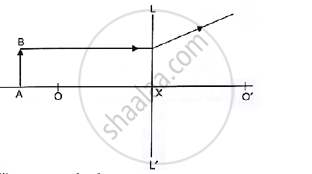Advertisements
Advertisements
Question
A convex lens of focal length 0.10 m is used to form a magnified image of an object of height 5 mm placed at a distance of 0.08 m from the lens. Calculate the position, nature and size of the image.
Solution
Given:
Focal length, f = 0.10 m = 10 cm
Object distance, u =-0.08 m =-8 cm
Height of the object, h = 5 mm = 0.5 cm
Applying lens formula, we get:
1/v-1/u = 1/f
or, 1/v = 1/f + 1/u
or, 1/v = 1/10 + 1/(-8)
Image distance, v =-80/2 =-40 cm
or, v =-0.40 m
Thus, the position of image is 0.40 m from the lens on the same side as the object (on the left of lens).
Magnification, m = h'/h = v/u
m = h'/0.5 = (-40)/(-8) = + 5
or, size or height of image, h' = 2.5 cm or 25 mm
Further, the value of magnification is positive; therefore, the image is virtual and erect.
APPEARS IN
RELATED QUESTIONS
Where should an object be placed so that a real and inverted image of the same size as the object is obtained using a convex lens?
Complete the following table:
| Instrument | Number of Convex Lenses |
Use |
| Simple Microscope | .............. | .............. |
| Compound Microscope | .............. | .............. |
| Telescope | .............. | .............. |
Where should an object be placed in front of a convex lens so as to obtain its real, inverted and magnified image?
What type of lens would you use as a magnifying glass? How close must the object be to the lens?
A convex lens of focal length 6 cm is held 4 cm from a newspaper which has print 0.5 cm high. By calculation, determine the size and nature of the image produced.
The diagrams (a) and (b) in Figure below show the refraction of a monochromatic ray of light through a parallel sided glass block and a prism respectively. In each diagram, label the incident, refracted emergent rays and the angle of deviation.

Study the diagram below.

what are the points O, O’ called?
Analyse the following observation table showing variation of image-distance (v) with object-distance (u) in case of a convex lens and answer the questions that follow without doing any calculations:
| S. No. | Object-Distance u (cm) |
Image-Distance v (cm) |
| 1 | –60 | +12 |
| 2 | –30 | +15 |
| 3 | –20 | +20 |
| 4 | –15 | +30 |
| 5 | –12 | +60 |
| 6 | –9 | +90 |
(a) What is the focal length of the convex lens? State reason for your answer.
(b) For what object-distance (u) is the corresponding image-distance (v) not correct? How did you arrive at this conclusion?
(c) Choose an appropriate scale to draw a ray diagram for the observation at S. No. 4 and find the approximate value of magnification.
Write the three characteristics of the image formed by a convex lens of focal length 20 cm for the object at distance (i) 10 cm, (ii) 30 cm, (iii) 40 cm, (iv) 60 cm from the lens.
Write scientific reason.
Adults need bifocal lens spectacle.
